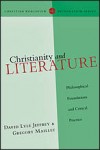When considering the correspondence theory of truth in Christianity and Literature: Philosophical Foundations and Critical Practice (Christian Worldview Integration Series. InterVarsity Press. 2011), David Lyle Jeffrey and Gregory Maillet refer to John Updike's Seven Stanzas at Easter (1960).* Enjoy this excerpt from a "bold, wonderfully learned manifesto ... [which] breathes a prophetic passion -- bracing, salutary and sometimes uncomfortable -- that transcends mere academic discussion and leaves the reader … [Read more...] about Correspondence theory & Updike’s “Seven Stanzas of Easter”
